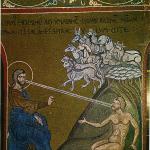Most of the customs and rituals that have survived to this day in our society contain fairly harmless and the most widespread traditions, in contrast to other, less well-known ones, which carry particular cruelty and excessive danger to human life. There are quite a lot of such rituals today, we will talk about some of them in our interesting article.
Self-mummification or suicide?
The tradition of turning your life into a nightmare originated in Japan at the end of the 19th century. People really believed that by mummifying themselves, they would achieve spiritual enlightenment and would never be reborn again in the future.
The process itself took quite a long time, about 6 years. To begin with, a person who decided to take such a desperate step went on a strict diet, which included only nuts and seeds. This was supposed to last 1000 days. With the help of such nutrition, a person completely lost fat.
The next 1000 was devoted to expelling fluid from the body. To do this, it was necessary to eat only the roots and bark of the pine tree. If after this at least someone managed to survive, they were given poisonous tea, which was prepared from the sap of the lacquer tree. This caused diarrhea and vomiting, which contributed to the complete removal of water from the body of the “future mummy.”
After this, the “suicide” (there is no other way to call him) sat down to meditate, awaiting his death in a small sealed room. Fortunately, self-mummification was banned in the 20th century, but, unfortunately, there are even more sophisticated and terrible rituals, which we will talk about below.
What are babies to blame for?
In India (Maharashtra state), the most terrible rituals in the world are still practiced in the Grishneshwor Temple. One of them is dropping babies from a 15-meter height. Yes, yes, you heard right, that’s right. This is necessary so that the child in the future has intelligence, luck and health. The ritual consists of lifting a naked baby to a height of 15 meters and throwing it. Below, his dad and his “inadequate successors” are waiting for him, who are catching the baby with an unrolled white sheet. The fact remains that over the past 1.5 centuries, 3 children have died. Why Hindus are happy about this is not yet entirely clear. After all, the child remains with serious psychological trauma for the rest of his life and is significantly delayed in development.

"Minghun" or posthumous marriage
In China, in the West, to this day they practice the most terrible customs and rituals that defy any logic and common sense. One of them is as follows: a man or woman who has never been legally married in their entire life should be buried together with a dead person of the opposite sex. Horror! The Chinese believe that by performing such a ritual, they will ensure the deceased a happy life with a “grave neighbor.” The parents of the “dead bride” must pay $1,200 (bride price). This custom leads to dire consequences. The trade in the dead in China has long been known, but that’s not all. People began to go crazy, desecrating the graves of the dead.
In recent years, according to the local press, the number of desecrations has begun to increase significantly. One such case occurred in Yangchuan Province. A young woman tried to buy the corpse of a girl who was not taken from the morgue. She explained this by saying that her deceased brother came to her in a dream and demanded that her “future wife” be immediately delivered to him. Agree, it's just a nightmare! Even worse, if for some reason the bride or groom died on the eve of the marriage ceremony, it still had to take place. Thus, the living groom had to marry the “dead bride.” Horrible!

Dead to be torn to pieces by vultures: ritual or bloodthirsty cruelty?
Another cruel tradition, included in the “most terrible rituals” section, comes from Tibet. Although it was practiced for quite a long time in the USA (Delaware). Buddha's successors always believed that after death the soul leaves, and the human body means nothing, it is like an empty dry tree that must be removed from the world. For this, “well-wishers” came up with the idea of giving “dead meat” to vultures (the good stuff should not go to waste). They dismembered the body into small pieces and gave it to the birds to be eaten.
But that's not all. After only the bones remain from the body, they grind them and make cakes from the flour, which are eaten by smaller birds.
The terrible rituals of different tribes also include the following: some, in order to always feel the presence of their deceased relative, grind his bones into flour and mix them with bananas. I think many have guessed what they do next with their children (for those who don’t understand, they eat).

"Dead" food
This tradition is one of the “most terrible modern rituals”, which is practiced in India to this day. Moreover, children also participate in this “fear”. An Indian tribe called Aghori, in order to get rid of the fear of their own death, eat dead fellow tribesmen who cannot be cremated (saints, pregnant women, children, unmarried women who died from an insect bite or lepers). They believe that “departure to another world” is an obstacle to spiritual enlightenment. Before eating “carrion,” the deceased is thoroughly soaked in river water and then eaten.

"Terrible Legs"
The most terrible rituals are known to be performed in China. Fortunately, many of them are not practiced in the modern world. One of these is “lotus feet”. The thing is that in old China, a beauty was considered to be one whose feet resembled a lotus. For this purpose, girls at the age of 4 had their feet tightly bandaged with bandages, which caused them unforgettable torment. They walked like this until they were 10 years old. After this, girls were taught a mincing and swaying gait (2-3 years). And then they were ready for marriage. The most interesting thing is that the girls were proud of their legs, despite the excruciating pain.
"Walking Corpses"
As has long been known, terrible rituals related to black magic are practiced in Indonesia. One of these really excites the mind. The ritual takes place in a city called Toraja. No matter how strange it may sound, there the corpses themselves go to their graves. And this happens because the cemetery there is quite far away, so local residents ask for help from black sorcerers, who temporarily revive the deceased, and he independently follows to the place of his burial. The only condition is that no one should touch the “living corpse”, otherwise it will fall and never rise again.

Useless old people
This tradition, according to the author, is simply the height of cruelty and insanity. And it lies in the fact that those who, to put it mildly, are fed up with old people, and caring for them is a burden, kill them. What do they do with those whose lives will soon come to an end? When a person reaches the peak of helplessness, the locals simply take him to the ocean and place him on an iceberg, where the poor fellow either freezes or dies of starvation. Some, in order not to suffer, jump into the icy water themselves. This is the attitude of the Eskimos towards the elderly.
Mitten made from poisonous ants
The most terrible rituals in the world are also carried out in South Africa. One of them is the initiation of a boy into a man. To do this, the baby must place his hand in a mitten filled with the most poisonous ants in the world. The hand should stay there for at least 10 minutes. Most often, such a ritual leads to blackening of the hand or temporary paralysis. The worst thing is that after such initiation, most die from If a man expressed a desire to become a real warrior, he must go through the procedure 20 times or more. It’s easy to guess that hardly anyone will live to see 20 times.

Wife's devotion
Fortunately, this ritual was banned back in the 20s of the 19th century. The thing is that in India it is customary to burn the body of the deceased. The worst thing is that his wife had to follow him. "In what sense?" - you ask. The woman had to put on the most beautiful outfit, walk around her burning husband 7 times and join him. Yes, yes, burn alive with him in order to continue living together in the next world. Like this! I wonder if the wife died, would the husband follow her?
Human stupidity and cruelty do not recognize any boundaries, this is proven by some customs that supposedly glorify God and teach children wisdom. In most cases, they are invented by mentally unstable people or real deceivers.
Ethiopia is home to one of the most unusual tribes in the world - the Mursi. They are considered the most aggressive ethnic group. All the men carry Kalashnikov assault rifles, which are handed to them illegally across the border. In addition, they start drinking in the morning, and, closer to lunch, they become uncontrollable.
Those warriors of the tribe who did not get machine guns, or who simply left them in their homes, carry sticks with them. With the help of these sticks they prove their leadership. The one who claims it must beat his competitors half to death.
This tribe probably belongs to the mutants of the Negroid race, because its appearance is significantly different from the usual standards of beauty. Both men and women are short, big-boned and bow-legged. Low foreheads, flattened noses, short necks. The bodies are flabby and sickly in appearance, with sagging bellies and hunched backs. There is almost no hair on their heads, and therefore all Mursi women constantly wear intricate headdresses of complex design, made from branches, rough skins, swamp shellfish, dried fruits, dead insects, someone's tails and some kind of stinking carrion. Their wrinkled, chewed faces, with small, narrow-set eyes, have an extremely angry and wary appearance.














Methodically killing the flesh of men by systematically giving them narcotic poison, women priestesses seem to destroy these physical earthly shackles, bringing closer the hour of liberation for the higher spiritual Beings languishing in them. They themselves are simple Spirits of Darkness, sent here to perform mystical ritual rites and have the right to return to their Lord - only after the natural death of the resulting body. Good does not exist without evil, light does not exist without darkness, and life does not exist without death. And each person in his earthly life serves one of the opposing forces, fulfilling the destiny given to him by the Creator. And it is not for us to judge whose path and faith is more correct. The ancient Mursi tribe is simply doing its duty.
While most of the rituals that survive in modern society involve harmless traditions common throughout the world, others, less well known, can be extremely painful and cruel. Unusual and dangerous rituals can be found in different parts of the world. We will tell you about several of them in this collection.
(Total 11 photos)

1. Cannibalism.
Aghori Babas who live in the Indian city of Varanasi are famous for eating the dead. They believe that man's greatest fear is the fear of death, and that this fear is an obstacle to spiritual liberation. By eating a dead person, you can get rid of fear and take the right path of enlightenment.
There are five types of people who cannot be cremated according to Hindu rules: saints, children, pregnant women, unmarried women, people who have died of leprosy or snake bites. These people are attached to the sacred river Ganges, from where they are subsequently pulled out and ritually consumed by the Aghori.

2. Dance of the Sun.
Native Americans were known to perform numerous rituals to honor the spirits of the land. Rituals are a means of communication with great spirits, and self-sacrifice means maintaining direct contact with the Tree of Life. The ritual of making direct contact with the Tree proceeds as follows: the skin on the chest of the participants is pierced with a skewer, which is attached with a rope to a pole representing the Tree of Life. Participants move back and forth, trying to escape while the skin of their chest is still tied to the post. This dance can last for several hours.

3. Self-flagellation.
Every year during the holy month of Muharram, followers of Shia Islam carry out a ritual of mass self-flagellation to commemorate the martyrdom of Hussein, the grandson of the Prophet Muhammad. Men beat their bodies with blades attached to chains. In a state of religious trance, they practically do not feel pain.

4. Vine jumping.
In the village of Bunlap, which is located on an island in the Pacific Ocean, a ritual called Gkol is performed. This ritual is, in a way, the predecessor of bungee jumping. The villagers sing, dance, some beat drums, and some men prepare for dangerous jumps. They tie vines around their ankles and jump from very high wooden towers built especially for this ritual. Participants in the ritual do not appear to be overly concerned about the possibility of breaking bones. They just jump and fly upside down. It is believed that the higher a person starts, the greater the blessing of the gods he will receive.

5. Voodoo and spiritual possessions.
Followers of the Voodoo cult can be found in parts of West Africa. One of the rituals is to accept into oneself, as into a kind of vessel, some other soul or spirit. In the photograph, a person connects with the spirit of the Earth, Sakpata. The spirit takes over the body, but the person remains conscious. After the ritual, the spirit does not leave the person for 3 days.

6. Sky burials.
In Tibet, Buddhists practice a strange sacred ritual called Jhator, or sky burial. Buddhists believe in the circle of rebirth, which means that there is no need to preserve bodies after death because the soul has moved on to another realm. It is customary to give the bodies of the dead to vultures as alms. In order to get rid of the body as quickly as possible, a special person cuts the corpse into pieces and scatters it around for the birds to eat.

7. Fire walks.
The festival takes place in Penang, Malaysia. One of the cleansing rituals involves walking barefoot on burning coals. It is believed that fire scares away evil spirits, enhances masculine strength and helps to free oneself from bad thoughts. For this purpose, hundreds of people walk along the lights.

8. Dancing with the dead.
Famadihana, which means "turning of the bone", is a traditional festival that takes place in Madagascar. Participants believe that the faster the body decomposes, the faster the spirit reaches the afterlife. Therefore, they dig up their loved ones in order to dance with them to music around the grave, and then rebury them. This strange ritual is performed every 2-7 years.

9. Piercing.
The annual Vegetarian Festival in Phuket, Thailand is a highly dangerous ritual that requires participants to pierce their cheeks with swords, knives, spears, hooks and the like. It is believed that during the ritual the gods put their bodies into a trance, protect them from evil and bring them good luck in the future.

10. Death rites.
The Amazonian Yanomami tribe is one of the most primitive in the world. In their opinion, death is not a natural phenomenon. It is customary in the tribe to cremate a deceased person, and mix his ashes with bananas and eat them so that the spirit of the deceased member of the tribe continues to live among their own.

11. Scarification.
The Kaningara tribe from Papua New Guinea practice a very unusual ritual that is aimed at strengthening the spiritual connection between members of the tribe and their environment. One of the ritual ceremonies is held in the “House of the Spirit”. The teenagers live in seclusion in the Spirit House for two months. After this period of isolation, they prepare for an initiation ceremony that recognizes their transition to manhood. During the ritual, the person's skin is cut with bamboo fragments. The resulting notches resemble crocodile skin. The people of this tribe believe that crocodiles are the creators of people. The marks on the body symbolize the teeth marks of a crocodile that ate the boy and left behind an adult man.
There are more than four thousand religions in the world. Some sacred rituals can safely be called strange and even creepy. We offer you a list of ten exotic religious ceremonies, but be careful - the descriptions of many of them should not be read by impressionable people.
"Sky Burial"
As you know, Buddhists believe in cycles of rebirth and reincarnation, so they do not see the need to preserve the body of the deceased after death. Moreover, some followers of the Buddha's teachings believe that the sooner the body turns to dust, the sooner the next life will begin for a person. In Tibet, this belief was embodied in a ritual called jator. During the burial ceremony, the body of the deceased is carried to the top of the mountain and left as an offering to the vultures.To speed up the procedure, sometimes the body is even cut into pieces and laid out in several places. Vultures are called "dakinis", which translates as "heavenly dancers". They play the role of angels, carrying a person's soul to heaven for the next incarnation. In the 1960s, Chinese authorities criminalized jator, calling the practice “barbaric.”

However, the ban met with strong resistance from Tibetans who believed in the sacred necessity of this rite, and starting in the eighties, sky burial was again legalized on the condition that it be carried out only in a few specially designated places.
"Thaipusam"
Thaipusam is a Hindu festival celebrated in various countries around the world, including Sri Lanka, India, South Africa and Malaysia. For many thousands of participants, the festival involves only a procession where people carry pots of milk as an offering to the gods. Only a few particularly pious Hindus perform a special ritual on this day. 
They pierce their cheeks and skin on their bodies with knitting needles and hooks, to which they attach jewelry that can weigh more than 30 kilograms. Participants in the ceremony claim that they fall into a kind of trance and do not feel any discomfort or pain. The meaning of the Thaipusam holiday is to honor the Hindu goddess Parvati, who gave the god of war and hunting Murugan a wonderful spear to fight demons. By piercing their flesh, Hindus protect their body from the penetration of any evil.

Sun dance
Many indigenous tribes of North America practice totemism and perform rituals dedicated to various spirits of the earth. One of the most common rituals among Indians is the sun dance, designed to bring health and a rich harvest to the tribe. And totemism is one of the oldest religions. 
Nowadays, the ceremony usually involves only drumming, singing and dancing around the fire, but in exceptional cases it is a brutal test of human endurance. The skin on the dancer’s chest is pierced in several places, a kind of weaving shuttle with a rope is threaded through the holes, and it is then tied to the Tree of Life deified by the tribe. The main participant in the ritual begins to move back and forth, trying to free himself from the shuttle.

Of course, this practice often resulted in serious injury or death, leading to its ban beginning in the late 19th century. However, official American authorities rarely interfere in the life of Indian reservations, and the “sun dance” in its full version is periodically performed today.
"El Colacho"
Christians around the world believe in the doctrine of original sin. According to him, every person is born in sin because of Adam and Eve's disobedience to God in the Garden of Eden. It is believed that a Christian can atone for this guilt by leading a righteous life. However, residents of the town of Castillo de Murcia in northern Spain perform a ritual to cleanse newborns of this sin - "el colacho", also known as the baby jumping festival. 
All children born in the last year are placed on mattresses along the street, and men dressed as devils jump back and forth over the mattresses to cleanse the babies of original sin. Although no incidents were documented during the holiday, the Pope appealed to the local Catholic Church demanding that it disassociate itself from such a dangerous practice.

Some Hindu communities practice a similar rite of child purification, in which infants (more than a hundred per year) are thrown from the roof of the temple onto blankets below. It is believed to bring good luck in life and fertility.
Self-torture
Self-torture - the act of cutting oneself with blows of a whip - has existed as a religious ritual for as long as religions have existed. Most often, self-torture was carried out as a voluntary penance to appease the gods. Now you can not only read about this action in books on the history of religion, but also see it with your own eyes. 
In the Philippines and Mexico, on Good Friday, true believers beat themselves with whips in order to get rid of their sins and, after death, take a place in heaven next to God. Many Shia Muslims in India, Pakistan, Iraq, Iran and Lebanon also torture themselves during the holy month of Muharram.

The purpose of the ceremony is to honor the martyrdom of the grandson of the prophet Mohammed Hussein ibn Ali, who was killed by the cruel caliph of the city of Kufa. Self-torture is very dangerous because it can lead to death from loss or blood poisoning.
"Tinka" or "Hit Your Neighbor"
The indigenous people of the South American Andes revere the goddess Pachamama, who, according to Incan mythology, is the patroness of hunters and peasants and can cause and prevent natural disasters. She is believed to send generous spoils and rich harvests as long as abundant blood sacrifices are made to her. Since the 17th century, the Bolivian Macha people have celebrated a holiday called “Tinku.” 
Simply put, it was a brutal fist fight involving many people intent on shedding as much blood as possible for the glory of the goddess. Huge crowds flocked from all over the area to take part in the annual mass brawl. Almost every year, deaths have been reported during the festival of blood.

“Tinku” is still held today, but fights take place in a one-on-one format. The number of deaths has fallen sharply in recent decades, and there have been none this century.
"Famadikhana"
Residents of Madagascar believe that the spirit of the deceased cannot join the ancestors until the body is completely decomposed. They perform a ritual that accelerates the transition of their beloved relatives to another world. This ritual is known as famadikhana, or "spinning the bones." On the website you can read about other strange funeral ceremonies. 
Living family members remove the dead from their graves or family crypts, dress them in new clothes and dance with them to joyful music. The holiday is held once every two to seven years. Interfering with the afterlife in this way helps bodies decompose faster. Although from the outside such an action seems frightening, the Malagasy themselves consider the ceremony fun and helping to maintain the connection between generations.
Human sacrifice
When our contemporary thinks of human sacrifice, he imagines ancient Egypt, where many of the pharaoh's servants accepted death to accompany their master to the land of the dead. It's hard to imagine this happening in our time. However, people are still sacrificed to the gods, most often in the Indian and African hinterlands. 
For example, in 2006, Indian police reported “dozens of victims over six months” in the city of Khurja, killed by Kali worshipers during religious rites. Many of the victims were children under three years of age. Worshipers of the goddess of death hoped to drive poverty out of the city in this way.

Ritual killings have been reported in Nigeria, Uganda, Swaziland, Namibia and many other African countries in recent years. In Uganda, for example, there is a whole underground market for services where you can order a sacrificial service from a shaman, which brings success in business.
Female circumcision
There are approximately 140 million women in the world who have been circumcised. Female circumcision involves partial or complete removal of the external female genitalia. In most cases, this occurs in unsanitary conditions, without the consent of the victim and without anesthesia. The procedure is mainly common in eastern, northeastern and western Africa and in some areas of Asia and the Middle East. Female circumcision is a pointless and traumatic procedureIt is believed that circumcision can protect women from promiscuity and adultery. Female circumcision is not typical for any one religion, but it is necessarily practiced by followers of teachings that postulate the subordinate role of a woman, her secondary status in relation to a man. In some cases, circumcision plays the role of an initiation ceremony into a religious group.
Cannibalism
Classical Hinduism prohibits cannibalism, and devout Hindus strongly condemn Aghoris. The Aghori tribe of India is known for their religious practices that involve eating dead bodies. Aghoris believe that fear of death is the greatest obstacle to spiritual enlightenment. By confronting the fear of death by eating the flesh of the dead, a person can overcome this barrier. 
However, Aghori are not the only ones who eat their own kind for the glory of higher powers. The Amazonian Yanomami tribe believes that death is not a natural phenomenon, but a disaster brought about by the gods. When a community member dies, his body is cremated and the ashes are eaten so that the spirit of the deceased can remain with the tribe.
Once upon a time, most of these rituals (except, perhaps, female circumcision and beating oneself and neighbors) had a practical meaning - for example, it was more convenient for Tibetans to “dispose” of their dead in this way due to the climate. But today, the blood rituals you read about are dangerous relics of the past that often result in loss of life, intentionally and accidentally. The editors of the site invite you to read about the deaths that occurred due to an absurd coincidence of circumstances.
Subscribe to our channel in Yandex.Zen
The Mayans are one of the most famous ancient peoples of Mesoamerica. The origins of this civilization date back to around 2000 BC. The Mayans built stone cities, created an efficient farming system, had a deep knowledge of astronomy, and performed inhumanely cruel sacrifices to hundreds of their gods.
One of the most famous May rituals is the ball game. Two teams, each of which had 7 people, gathered on a large field and tried to throw a special rubber ball into the hoop. Of course, this was not a simple sports competition, but a real religious ritual, in which everything was clearly regulated. The field is 180 by 120 meters in size, the rings are at a height of 4 meters, the ball, which in this game symbolized the sun, could not be touched with hands and feet. They played with their shoulders, body, head, hips, and also using special bats. The conditions were very difficult, which is why the games lasted 3-4 days without a break. The game stopped as soon as the first ball was thrown into the ring. This action ended, as usual, with sacrifices. The Mayans made do with animals, but the warlike Toltec tribes that later replaced them developed their own system, according to which the captain of the losing team cut off the head of the player who scored the ball. Everything is fair - only the most worthy were sent to the gods.

Dance of Fire Purification
The Mayans did not have many humane rituals in which they did without killing or mutilation, and this dance of fiery cleansing is one of them. This is probably why it was not held so often, only in those years that the priests declared the most unlucky and dangerous. The ceremony began late at night. First, in a spacious, specially designated place, a large fire was built, around which a ritual dance began. Later, when only hot coals remained from the fire, they were scattered around and the culmination of the ritual came: the dance had to be completed on these coals. Well, this procession of barefoot Indians was led by the high priest himself.

Ritual of "stringing"
Human blood played a special role in Mayan culture and religion, so ritual bloodletting was very common, which, by the way, did not always involve the death of the victim. The “stringing” ritual can be called the most unusual version of non-lethal ritual bloodletting among the Mayans. Its essence was that all the men of the same clan, having gathered in the temple, one by one pierced their penises with a sharp thorn, and threaded a lace or rope through the holes made. One common for all. According to the Mayans, the blood contained the soul and vital energy. Finding themselves thus “strung” on a rope soaked in common blood, they symbolized unity with their divine ancestors. It is noteworthy that later this ritual began to be practiced among women. They pierced their tongues.

Sacrifices to the rain god
Chac, or Tlaloc, is one of the most significant Mayan gods, who is directly associated with rain and thunderstorms. According to Indian beliefs, the sacrifices were supposed to appease this god so that he would send rain to the people. The difficulty was that God, as the Mayans believed, had a special weakness for small creatures, so the bulk of the sacrifices, according to the remains found in excavations, were children from 3 to 11 years old. The Indians believed that by sacrificing the lives of some, they preserved life as a whole. During the ritual, children were thrown into karst wells filled with water, considered sacred, which are usually formed when the roof of a cave collapses. Many of the children were thrown into the well while still alive, while others underwent various ritual “treatments” before being offered to the gods: some victims were skinned by the priests, others were dismembered.

Ritual of "soul-blood"
Not everyone was suitable for this ritual, but only innocent young men, since the purity of the “soul-blood” was important to the priests. The victim was tied to a pole in the square and shot either with spears or with bows, like a target. At the same time, it was strictly forbidden to inflict mortal wounds on him. The victim had to die long and painfully from total blood loss. It was believed that it is with the flowing blood that the soul “flies away” to God.

Climbing into the frozen sky
The ritual is especially popular among the Andean mountain tribes. It consisted in delivering the victim to the top of the mountain, in the permafrost region, in order to place him still alive in a crypt in which he would die from the cold. The victim herself is under the influence of intoxicants and dies before she even has time to come to her senses. Most often, prisoners captured during the war were sacrificed in this way. However, only specially selected, beautiful children - devoid of physical disabilities and who had not reached puberty - could become especially trusted messengers to the ancestor gods.

Ceremonial sacrifices
The same ones that are so widely covered in films, books, and even comics. Sacrifices were made only in exceptional cases: epidemics, strife, droughts, the beginning or end of a war. At the top of the temple, the high priest smeared the person intended for sacrifice with sacred paint, and placed a high sacrificial cap on his head. Next, the priest’s four closest assistants held the victim tightly, and the priest himself used a serrated knife to open her chest and take out the living heart. This had to be done extremely quickly and very accurately in order to have time to bring the still beating heart to the statue of the deity before “the soul flew away.” At this time, the lifeless body of the victim was rolling down the steps of the pyramid. There, other servants had to remove the skin from the corpse, all except the feet and hands. Having taken off the ritual robes, the priest “put on” this skin and in this form led the ritual dance.

Take over the power
A variety of people became victims of such rituals: the most worthy representatives of the tribe, prisoners captured in battle, great warriors who glorified their names. It was customary to burn the bodies of prisoners and slaves after the ceremony. But they treated the warriors differently. The Mayans believed that the best qualities of a person - strength, courage, courage - could be transmitted through his flesh. Therefore, in cases where brave warriors were sacrificed, the ritual ended with ritual cannibalism. The Andean tribes were even more cruel. There, a worthy chosen one was tied naked to a pole and, cutting him into pieces, his flesh was immediately eaten. As a result, the sufferer was eaten alive by others, burying him in their wombs. But the most important thing for the victim was not to show his suffering during the ritual. Only then were his bones placed in the crevices of the mountains and worshiped as a shrine. Otherwise, if the unfortunate person “blew out a groan or a sigh,” then his bones were broken with contempt and thrown away.

Flattening of the head
The Mayans adhered to very unique standards of beauty. They considered the ideal skull to be as flat as possible, and for this they were ready to do anything. There was a special custom, the essence of which was precisely to give a flat shape to the skulls of infants, with the help of planks tightly tied with ropes. This process was very painful and often even ended in the death of the child.


















